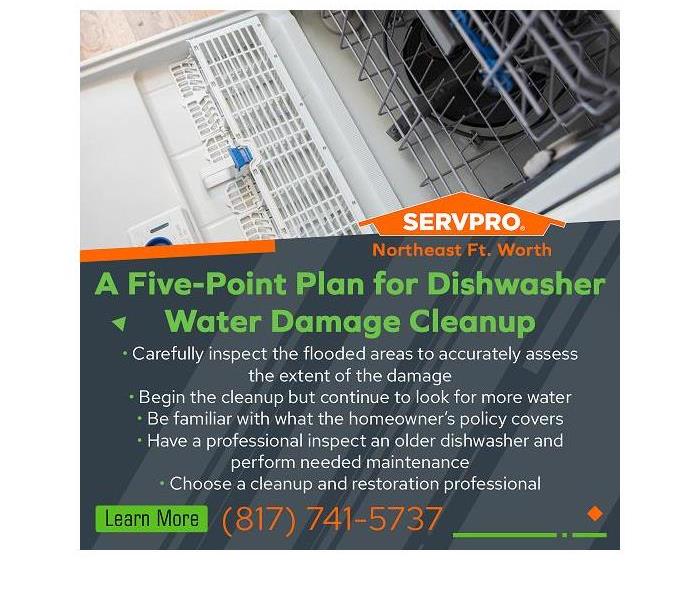Helping Homeowners Deal with Water Damage from a Dishwasher Malfunction
4/13/2022 (Permalink)
Blog Summary: SERVPRO of Northeast Fort Worth explains ways homeowners can overcome the challenges of water damage caused by a dishwasher flood.
A flooded kitchen presents several water damage restoration challenges, none of which are easily resolved. These multifaceted problems need immediate attention to prevent advanced secondary damage, which could include a mold infestation.
The challenges of water damage can prove to be a frustrating nightmare when an appliance such as the dishwasher floods the kitchen floor. A water damage disaster requires professional attention from trained technicians with the proper water removal equipment and drying techniques to quickly resolve the matter.
Within the kitchen, the dishwasher is a common source of leakage, and this appliance may leak for many different reasons. Consult a professional plumber or appliance repairman with the proper credentials to accurately diagnose the origin of the leak.
A Five-Point Plan for Dishwasher Water Damage Cleanup
1. Carefully inspect the flooded areas to accurately assess the extent of the damage.
Before initiating the cleaning process, inspect the kitchen and adjacent rooms to determine the extent of the flooding. A floor-mounted electrical outlet involved in the flood presents a serious risk hazard, especially if the fixture is not a GFCI outlet. A GFCI (Ground-Fault Circuit Interrupter) will automatically break the electrical circuit when an overload or arc occurs. Also, other electrical appliances may be impacted by the floodwater. To remove all doubt and to ensure safety, turn off the power to all the affected areas.
If the kitchen is flooded, expect to find water under the dishwasher. If the appliance has an access panel on the bottom of the unit, check for water, and be sure to mop up any hidden moisture. Other floor-mounted cabinets in the kitchen may suffer water damage, and the cabinets can absorb the water if the remediation process is delayed. Remember, custom wooden cabinets can be very costly to repair or replace.
2. Begin the cleanup but continue to look for more water.
Not only may water be under the dishwasher and cabinets, but it may have also spread to areas under the stove, refrigerator, and freezer. The safest course of action is to turn off the power to these appliances before touching them. Standing in a pool of water and touching an appliance can have shocking consequences.
Mop up the bulk standing water first to prevent excess bulk water from seeping back under the appliances. Pay special attention to drywall and baseboards. Accelerate the drying process by stationing two or three powerful fans to cross-ventilate the flooded area. Over the next month, periodically inspect the areas under cabinets and appliances for signs of a mold infestation. The kitchen is, at times, a living space with excessive heat and high concentrations of moisture. The introduction of dishwasher flood water exacerbates the situation. The strategic placement of desiccants can facilitate the drying process, making it more difficult for mold spores to grow.
3. Be familiar with what the homeowner’s policy covers.
The standard homeowner’s policy does cover water damage caused by a mechanical or plumbing failure dishwasher. If lack of maintenance was the issue that led to the leak, the policy might not cover the flood damage. Reach out to the insurance company for clarification and advice on what steps to take moving forward.
4. Have a professional inspect an older dishwasher and perform needed maintenance.
An inspection and basic maintenance can prevent a water damage disaster and the headache that accompanies the incident. A dishwasher may give small hints of a larger impending disaster. Look for small pools of water under the front of the unit. Periodically check under the appliance for hidden water leaks.
5. Choose a cleanup and restoration professional.
Enlist the services of a licensed, bonded, and insured property damage restoration company to handle a large-scale flood from a dishwasher malfunction or supply line leak. The professional equipment can remove the water, dehumidify the environment, and perform advanced structural drying behind walls, under cabinets, and under flooring. The rapid response, as well as the rapid water removal and drying process, helps avoid wood rot, warping, buckling, the blistering of paint and wallpaper, and mold infestations.
For more details about SERVPRO of Northeast Fort Worth’s water damage cleanup services in the 76244 area, email the damage restoration company at office@SERVPROnortheastftworth.com. The office can also be reached by calling (817) 741-5737.





 24/7 Emergency Service
24/7 Emergency Service
